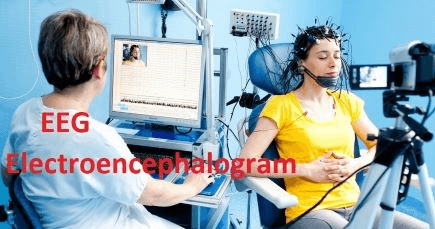What is the full form of EEGEEG: ElectroencephalogramEEG stands for Electroencephalogram. It is a test that is performed to check the electrical activity of the brain. The brain cells, which are called neurons, communicate with each other through electrical impulses. 
EEG provides a measure of brain waves, i.e., how the brain functions over time. It tracks and records brain wave patterns or the electrical signals of the brain. The machine used to perform this test comes with small metal discs with thin wires, which are called electrodes. These electrodes are placed on the scalp, where it sends signals to a computer to record the results. Normal brain activity makes a normal or recognizable pattern, but for abnormal brain activity, the pattern may be distorted or unrecognizable. How EEG Works:EEG is a safe and painless procedure. The electrodes placed on the scalp pick up electrical activity from the brain cells (neurons) inside your brain and forward it to a machine, where they are displayed as a series of lines recorded on a moving paper or displayed on a computer screen. After getting the results, the technician will take the electrodes off. A doctor who specializes in the brain, such as a neurologist, will analyse the recordings of your brain wave pattern. Why is EEG Performed?The EEG is performed to diagnose the following medical conditions or under the following circumstances:
RisksEEGs are painless and safe. Those who have epilepsy may occasionally purposefully induce seizures during the exam, but, if necessary, adequate medical treatment is given. How do you get ready
Additional safety measures
What to anticipateDuring an EEG:During an EEG, you'll experience minimal to no discomfort. No feelings are transmitted by the electrodes. Your brain waves are only being recorded. You can anticipate the following happening during an EEG:
An EEG normally lasts between 20 and 40 minutes once the electrodes are positioned. You must rest while being tested for specific problems. The exam may be extended in the situation.
Longer monitoring can be done outside of an office or a hospital with ambulatory EEGs (AEEGs). These EEGs, however, are not always a possibility. The possibility of recording during a seizure is increased by the fact that this test can capture brain activity over a period of many days. A mobile EEG is less effective at distinguishing between epileptic seizures and nonepileptic seizures than inpatient video EEG surveillance. After the Test:The technician removes the electrodes or cap following the test. After the operation, you should have no adverse effects if you didn't take a sedative. You ought to be able to resume your regular schedule. It will take some time for the effects of any sedatives you may have taken to start to wear off. Make arrangements for someone to drive you home. Rest after you get home and avoid operating a vehicle for the remainder of the day. ResultsThe recording is interpreted by physicians skilled in EEG analysis, who then report the findings to the physician who requested the EEG. To discuss the test findings, you might need to make an appointment with the doctor's office. Bring a friend or family member with you if you can so they can assist you in recalling what was said at the appointment. Make a list of inquiries to bring up with your physician, such as:
Next TopicFull Forms List
|
 For Videos Join Our Youtube Channel: Join Now
For Videos Join Our Youtube Channel: Join Now
Feedback
- Send your Feedback to [email protected]
Help Others, Please Share










